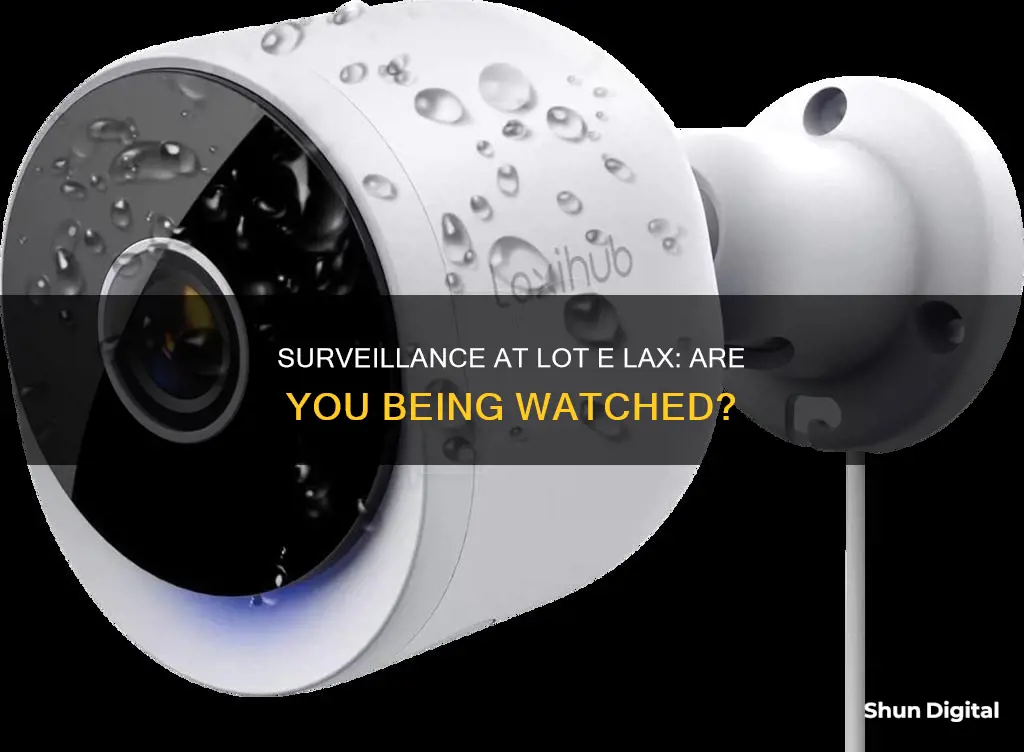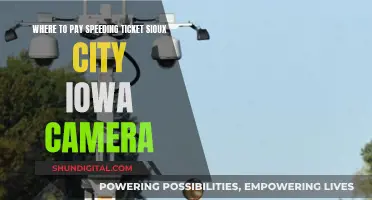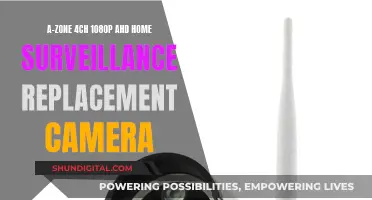
Los Angeles International Airport (LAX) has a comprehensive security system in place, including surveillance cameras monitoring the facility. In 2002, the airport announced plans to add 1,200 surveillance cameras to increase security, addressing concerns about evacuations and criminal activity. This upgrade aimed to integrate four existing systems with a total of 300 cameras used by different entities at the airport. LAX also offers parking lots with 24/7 video surveillance, ensuring the safety and security of travellers' vehicles. These parking lots provide convenient and economical options for travellers, with rates ranging from $7 to $17 per day for long-term parking.
| Characteristics | Values |
|---|---|
| Surveillance cameras | Yes |
| 24/7 surveillance | Yes |
What You'll Learn

LAX spent $29.7 million on a new CCTV system
Los Angeles International Airport (LAX) has invested over $1.6 billion in safety and security since 9/11. Three recent projects alone totalled just over $50 million. A significant portion of this, $29.7 million, was allocated to a new, expanded closed-circuit television system, or CCTV. This upgrade was necessary, according to Dominic Nessi, deputy executive director/chief information officer for Los Angeles World Airports (LAWA). The previous system was outdated, with obsolete hardware and software, and it was a burden to support. The age of the system meant that additional features could not be added, and it did not provide the necessary flexibility for public safety, operations, and maintenance personnel to effectively manage the airport.
The new CCTV system at LAX includes an airport-wide video management system and a video storage system. These systems will help airport police manage the streaming and storage of video evidence. The project has also increased the number of CCTV cameras from 1,000 to approximately 3,000. The new cameras are a mix of stationary and pan-tilt-zoom models and capture video of everything going on inside the airport environment, including perimeters, Customs, TSA checkpoints, corridors, and curbside monitoring.
The upgraded CCTV system offers several advantages over the previous system. Moving from analog to digital CCTV allows for greater scalability, so LAX can easily add more cameras to the system. The new digital system also provides improved image quality, with high-definition television-quality video that meets industry standards. The system makes video playback available to authorised users anytime and almost anywhere, and it enables searches of video footage by date, time, pixels, etc., making it easier to reconstruct events. Additionally, the system has built-in redundancy, ensuring that there is no single point of failure. If hardware or software fails in one area, the system will still capture and receive video without gaps in coverage.
The new CCTV system at LAX is part of the airport's commitment to enhancing security and improving its physical security posture. As one of the world's busiest airports, with more than 61 million passengers annually, investing in security updates is crucial. The upgraded CCTV system will help to decrease airport crime and improve the overall safety and security of the airport.
Replacing Polaroid 600 Camera Battery: Step-by-Step Guide
You may want to see also

The number of cameras at LAX increased from 1,000 to 3,000
In 2002, it was announced that the number of cameras at LAX would increase from 300 to 1,500 by December 2004. This was part of a $20 million security upgrade by the city agency that operates the airport. The new system would integrate four existing independent camera systems at the airport, and airport police would be able to view pictures from all 1,500 cameras from a new centralised monitoring station.
The additional cameras were intended to curb evacuations and more closely monitor terminals for criminal activity. The upgrade followed strong criticism of the city's failure to capture on tape the fatal Fourth of July shooting at the Tom Bradley International Terminal. While officials stated that cameras would not have prevented the shooting, they said that video of the incident would have helped with the subsequent investigation.
The new security camera program would allow law enforcement officers to tap into the system wirelessly using a hand-held computer and pull down live photos or video clips of a suspect. This technology had been tested at London's Heathrow Airport but had not yet been used regularly in a public place like LAX.
Having immediate access to images of criminal suspects or perpetrators of security breaches would help police find individuals more quickly and reduce terminal evacuations. This would address issues such as a security breach in Terminal 5 that forced the evacuation of the airport's entire south side, delaying 150 flights and stranding 8,000 passengers.
LAX parking lots are also under video surveillance 24/7, contributing to the overall security and safety of the airport.
Achieving Flawless Skin Tone in Camera Raw
You may want to see also

The new cameras are digital and IP addressable
In 2002, it was announced that LAX would be adding 1,200 surveillance cameras to improve security. The city agency that operates the airport planned to spend up to $20 million to add these cameras to the airport's nine terminals and 3,500-acre airfield by December 2004. Each terminal would receive up to 150 new cameras.
The new cameras will be installed in facility curbs, ticket lobbies, terminal doors, and the airfield. The addition of these cameras will enable a more comprehensive view of the airport, improving security and helping to deter criminal activity.
LAX's new camera system is a significant upgrade that will enhance security and improve the efficiency of law enforcement operations at the airport. With centralised monitoring and wireless access, the new digital and IP addressable cameras provide a more advanced and flexible solution for ensuring the safety of passengers and staff.
LCD Mode: YI Action Camera's Secret Weapon
You may want to see also

The old system included obsolete, patched-together hardware and software
The old surveillance system at LAX, Los Angeles International Airport, included obsolete, patched-together hardware and software. The airport's security system was in dire need of an upgrade, as evidenced by the fact that it failed to capture the fatal Fourth of July shooting at the Tom Bradley International Terminal on tape. This incident highlighted the shortcomings of the existing system, which consisted of four separate systems that operated independently of each other. These four systems, totalling 300 cameras, were used by different groups: airport police, operations personnel, airlines, and various U.S. agencies. However, none of these cameras were present in the ticket lobbies, which was a major gap in their security measures.
The old system was also not comprehensive enough to meet the airport's security needs. For example, the lack of cameras in the ticket lobbies meant that police officers had to be stationed there to monitor the area. This was not only inefficient but also posed challenges in investigating incidents, as evidenced by the shooting incident. The obsolete system made it difficult to sort out what happened and identify the perpetrator, hindering the follow-up investigation.
The city agency that operates LAX recognised the urgency to modernise and enhance the airport's security infrastructure. They announced a plan to invest up to $20 million to add 1,200 closed-circuit television cameras by December 2004. This upgrade aimed to address the limitations of the old system by integrating the four existing independent systems and adding new cameras in key areas. Each of the airport's nine terminals would receive up to 150 new cameras, significantly improving coverage.
The new system would be a centralised monitoring solution, allowing airport police to view footage from all 1,500 cameras in one location. This upgrade would make LAX the first airport in the U.S. to have such a comprehensive surveillance system. Additionally, law enforcement officers would have wireless access to the system through handheld computers, enabling them to pull live photos or video clips of suspects. This technology had been tested at London's Heathrow Airport but had not yet been regularly implemented in a public space like LAX.
The upgraded system promised to enhance security and improve the efficiency of investigations. With immediate access to images or footage of criminal suspects or security breaches, police would be able to locate and apprehend individuals more quickly, reducing the need for terminal evacuations. This modernisation of the airport's security infrastructure was a significant step towards bolstering safety measures and addressing the limitations of the old, patched-together system.
Focusing a Studio Camera: The Ultimate Guide
You may want to see also

The new system improves image quality
In 2002, the city agency that operates LAX announced plans to spend up to $20 million to add 1,200 closed-circuit television cameras in the airport's nine terminals and on the 3,500-acre airfield by December 2004. This security upgrade was intended to curb evacuations and more closely monitor terminals for criminal activity at Los Angeles International Airport. Each terminal would receive up to 150 new cameras, quintupling the number of surveillance cameras focused on facility curbs, ticket lobbies, terminal doors, and the airfield.
Prior to the upgrade, ticket lobbies at the airport lacked video cameras, as evidenced by the absence of footage during the fatal Fourth of July shooting at the Tom Bradley International Terminal. While officials acknowledged that cameras would not have prevented the shooting, they emphasised that video evidence would have aided the subsequent investigation. The new system addresses this gap by ensuring comprehensive coverage of high-traffic areas, including ticket lobbies and terminal doors.
The upgraded camera system also meets federal guidelines, which require cameras to be installed at the entrances and exits of security checkpoints. This not only enhances security but also ensures compliance with regulatory standards.
In addition to improved image quality, the new system provides law enforcement officers with wireless access to the camera network. Using handheld computers, officers can pull down live photos or video clips of suspects, enabling quicker response times and more efficient investigations. This technology had been tested at London's Heathrow Airport but had not yet been regularly implemented in a public place like LAX.
The comprehensive nature of the new system, with its improved image quality and centralised monitoring capabilities, positions LAX as a leader in airport security. This upgrade not only enhances the safety of passengers and staff but also reduces the need for terminal evacuations, minimising inconveniences for travellers.
Charging Your CoFunkool Camera's Lithium Battery: A Step-by-Step Guide
You may want to see also
Frequently asked questions
Yes, Lot E at LAX has surveillance cameras. All parking lots at LAX have 24/7 security, surveillance cameras, and either fenced-in or guarded properties.
Surveillance cameras at LAX are meant to deter theft and monitor the airfield, curbs, ticket lobbies, and terminal doors for criminal activity.
Yes, there are 1,500 cameras at LAX that are monitored from a centralized station.
Yes, there are surveillance cameras in the airport's nine terminals.
The effectiveness of the surveillance cameras at LAX is unclear. While they are meant to curb evacuations and monitor for criminal activity, there was a shooting at the airport in 2002 that was not captured on tape.







